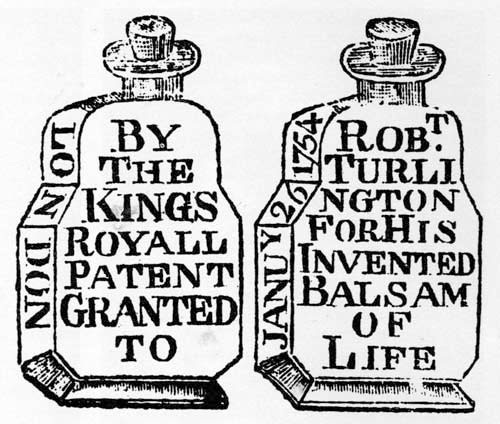Turlington's Balsam on:
[Wikipedia]
[Google]
[Amazon]
 Turlington's Balsam of Life was a
Turlington's Balsam of Life was a
 Turlington's Balsam of Life was a
Turlington's Balsam of Life was a patent medicine
A patent medicine, sometimes called a proprietary medicine, is an over-the-counter (nonprescription) medicine or medicinal preparation that is typically protected and advertised by a trademark and trade name (and sometimes a patent) and claimed ...
developed by English merchant Robert Turlington.
Background
He succeeded in obtaining aroyal patent
Letters patent ( la, litterae patentes) ( always in the plural) are a type of legal instrument in the form of a published written order issued by a monarch, president or other head of state, generally granting an office, right, monopoly, titl ...
from King George II George II or 2 may refer to:
People
* George II of Antioch (seventh century AD)
* George II of Armenia (late ninth century)
* George II of Abkhazia (916–960)
* Patriarch George II of Alexandria (1021–1051)
* George II of Georgia (1072–1089)
* ...
in 1744, which gave him the right to pursue anyone attempting to pass off their own product as his, one of the earliest medicinal patents. In his patent application Turlington claimed that the balsam
Balsam is the resinous exudate (or sap) which forms on certain kinds of trees and shrubs. Balsam (from Latin balsamum "gum of the balsam tree", ultimately from Semitic, Aramaic ''busma'', Arabic ''balsam'' and Hebrew ''basam'', "spice", "perfume ...
contained 27 ingredients, and was effective in the treatment of "kidney and bladder stones, cholic, and inward weakness", a list of ailments he greatly expanded upon in a 46-page brochure printed shortly afterwards. Turlington's Balsam quickly became popular in England and in the American colonies.
Packaging
During the 17th and 18th centuries, the manufacturers of patent medicines began to use packaging as a tool to differentiate their products from those of their competitors, as there was often little to visually distinguish between the medications themselves. In Turlington's case that resulted in his changing the shape of the bottle containing his balsam at least four times in the ten years following the granting of his patent, culminating in an elaborately embossed tablet-shaped bottle introduced in 1754.References
Notes
Citations
Bibliography
* * * {{refend Patent medicines